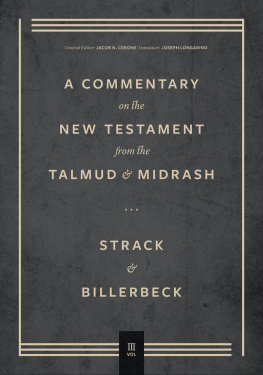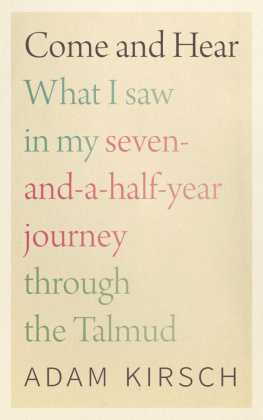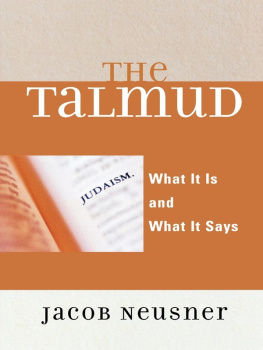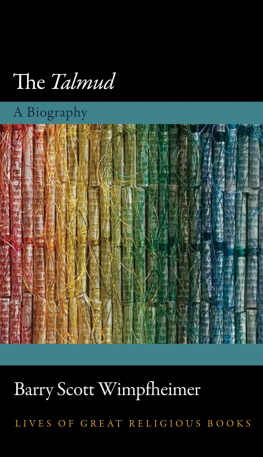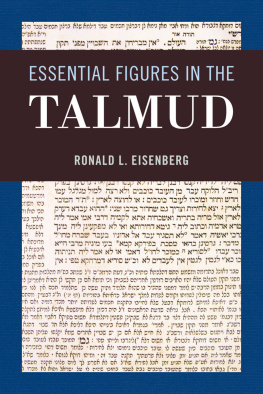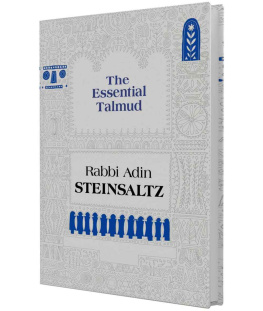Steinsaltz Adin - A Beginners Guide to the Steinsaltz Talmud
Here you can read online Steinsaltz Adin - A Beginners Guide to the Steinsaltz Talmud full text of the book (entire story) in english for free. Download pdf and epub, get meaning, cover and reviews about this ebook. City: Northvale;N.J, year: 1999, publisher: Jason Aronson, Inc., genre: Religion. Description of the work, (preface) as well as reviews are available. Best literature library LitArk.com created for fans of good reading and offers a wide selection of genres:
Romance novel
Science fiction
Adventure
Detective
Science
History
Home and family
Prose
Art
Politics
Computer
Non-fiction
Religion
Business
Children
Humor
Choose a favorite category and find really read worthwhile books. Enjoy immersion in the world of imagination, feel the emotions of the characters or learn something new for yourself, make an fascinating discovery.

- Book:A Beginners Guide to the Steinsaltz Talmud
- Author:
- Publisher:Jason Aronson, Inc.
- Genre:
- Year:1999
- City:Northvale;N.J
- Rating:4 / 5
- Favourites:Add to favourites
- Your mark:
- 80
- 1
- 2
- 3
- 4
- 5
A Beginners Guide to the Steinsaltz Talmud: summary, description and annotation
We offer to read an annotation, description, summary or preface (depends on what the author of the book "A Beginners Guide to the Steinsaltz Talmud" wrote himself). If you haven't found the necessary information about the book — write in the comments, we will try to find it.
A Beginners Guide to the Steinsaltz Talmud — read online for free the complete book (whole text) full work
Below is the text of the book, divided by pages. System saving the place of the last page read, allows you to conveniently read the book "A Beginners Guide to the Steinsaltz Talmud" online for free, without having to search again every time where you left off. Put a bookmark, and you can go to the page where you finished reading at any time.
Font size:
Interval:
Bookmark:
Judith Z. Abrams is a woman with a mission: She wants to bring the beauty of Talmud to as many people, and with as much depth, as possible. To that end, she has published many books on rabbinic literature, including judaism and Disability: Portrayals in Ancient Texts from the Tanach through the Bavli (Gallaudet University Press), which was the recipient of the Koret Jewish Studies Publication Program Publication Subsidy for 1998, The Talmud for Beginners, Volumes I, II, and III Oason Aronson Inc.), and Leam Talmud: How to Use the Talmud: The Steinsaltz Edition Oason Aronson Inc.). Rabbi Abrams and her husband, Steven, have co-authored jewish Parenting: Rabbinic Insights aason Aronson Inc.) and she has also written a number of childrens books. Rabbi Abrams earned her Ph.D. in rabbinic literature from the Baltimore Hebrew University and teaches across the country. She is the founder and director of Maqom: A School for Adult Talmud Study, where anyone can learn Talmud, regardless of their background. Maqom study materials are available on the Internet (http://www.compassnet.com/-maqom). Rabbi Abrams and her husband live in Houston with their three children, Michael, Ruth, and Hannah.
All beginnings are hard, say the sages (Mekhilta, Parshat Bachodesh 2). This is true evenperhaps I should say especiallywhen it comes to the study of Talmud. We know we ought to want to study, but the Talmud often feels foreign despite our knowing that it belongs to us. This book is designed to help ameliorate the first pangs of Talmud study by presenting Rabbi Steinsaltzs translation with explanations and insights from learners who began with no adult knowledge of Talmud and who became knowledgeable of the text. It is my heartfelt hope that this book will serve as a life preserver for those just learning to swim in the sea of the Talmud.
A book is never just the product of the authors efforts and this fact is particularly true in the case of this book. I would like to thank God for the opportunity to do this work. My great gratitude goes to Arthur Kurzweil for asking me to write this book. I also want to thank the students to whom I have taught this material, especially the Talmud classes at Congregation Emanu El, the Jewish Community Center, and the Federation, all in Houston, Texas; and PARR, the Pacific Association of Reform Rabbis. As usual, I have learned more from them than they have learned from me. Thanks also go to Marsha Schneider for her assistance in typing and for helping Maqom to grow and become more efficient. Id like to thank Michael Rubinstein of Houston for his because Im your father, thats why. Finally, I thank my husband, Steven, and our children, Michael, Ruth, and Hannah, for their love and support.
I would like to especially thank the contributors whose insights youll find on these pages. Here are the students you will meet:
Shirley Barish has been in the field of Jewish education for over thirty years. She has authored several books for teachers and writes a teachers newsletter six times a year.
Ken Carr is the assistant rabbi of Congregation Beth Am, Los Altos Hills, California. He endeavors to integrate continuing study into his rabbinic life.
Mark Frydenberg is a software developer and educator. He is a member of the Progressive Chavurah of Boston and Temple Beth Israel of Waltham, Massachusetts, and is currently working on a Siddur project with members of chavurot across North America.
Naomi Mara Hyman is the editor of Biblical Women in the Midrash: A Sourcebook Oason Aronson Inc., 1997) and a rabbinical student in the ALEPH Simcha program.
Robert E. Reichlin is a clinical psychologist specializing in problems of adulthood and aging. He is particularly interested in Talmud, Biblical Hebrew, and the integration of historical and traditional approaches to the study of Torah.
H.J. Stern is an attorney practicing primarily probate and family law in Houston, Texas. He has been studying Talmud for several years.
Stephanie Rosenthal Odie is on a spiritual journey toward a Primary Jewish Life by. engaging in the study of Torah, immersion in prayer, and the performance of mitzvot.
Elizabeth Weinberg is a psychodynamically oriented psychiatrist living in Houston with her husband, a lawyer and musician, as well as two cats and an iguana. She has been studying Talmud for several years.
Except where Rabbi Steinsaltzs edition is cited, or unless otherwise noted, translations are the authors own. Side notes concerning sages, concepts, and language come from Rabbi Steinsaltzs other English language volumes of the Talmud or from his Reference Guide.
Authors Note: The following two pages are the actual introduction by Rabbi Steinsaltz to the Talmud chapter we will be studying.

And if you sell something to your neighbor, or buy something from your neighbors hand, do not oppress one another (Leviticus 25: 14).
And you shall not oppress one another, but you shall fear your God, for I am the Lord your God (Leviticus 25: I 7).
You shall neither vex a stranger nor oppress him, for you were strangers in the land of Egypt (Exodus 22:20).
And if a stranger sojourns with you in your land, you shall not vex him (Leviticus 19:33).
T he two principal themes of this chapter are the rules governing the acquisition of movable property, and the laws of onaah (which concern financial and verbal wrongdoing). One of the general questions arising in connection with the laws of acquisition is how and when acquisition takes place - i.e., at precisely what point does the transfer of ownership take effect when property is purchased? Does the buyer gain title to the property as soon as he pays for his purchase, or only after he takes physical possession of the merchandise? If monetary payment cannot effect a sale, does it have any legal validity? And is a verbal agreement between the buyer and the seller in any way binding? The chapter opens with the specific issue of the rules governing an exchange of coins, and deals with a fundamental problem: How is money defined? Is money an absolute concept, which invariably refers to a particular means of acquisition, or is it a relative notion, the definition of which changes with the circumstances? This question has ramifications with regard to the laws of acquisition and of onaah, as well as to the laws of interest (discussed in the next chapter).
The laws of onaah fall into two categories: (I) Monetary wrongdoing, whether because the seller overcharged or the buyer underpaid. (2) Verbal wrongdoing, i.e., taunting other people and hurting their feelings.
Numerous questions arise in connection with the Torahs prohibition against financial wrongdoing: Precisely what is considered overcharging? Does the prohibition apply only if one overcharges a fixed sum (or by a fixed percentage), or even in a case of minimal overcharging? What legal remedies exist when one overcharges or underpays? Is fraud in business an offense punishable in court, or is it merely subject to civil litigation? And is a sale entailing fraud valid, or void? Must the party who was defrauded be reimbursed, and if so, to what extent? Does the prohibition against ana ah apply equally to all people and transactions, or not?
Verbal oppression is also examined. Precisely what is considered verbal wrongdoing? Are there cases where this is permitted, and if so, what are they? Does this prohibition apply equally to all people?
These general issues, along with their specific applications, are dealt with in this chapter.
And others say
Font size:
Interval:
Bookmark:
Similar books «A Beginners Guide to the Steinsaltz Talmud»
Look at similar books to A Beginners Guide to the Steinsaltz Talmud. We have selected literature similar in name and meaning in the hope of providing readers with more options to find new, interesting, not yet read works.
Discussion, reviews of the book A Beginners Guide to the Steinsaltz Talmud and just readers' own opinions. Leave your comments, write what you think about the work, its meaning or the main characters. Specify what exactly you liked and what you didn't like, and why you think so.

